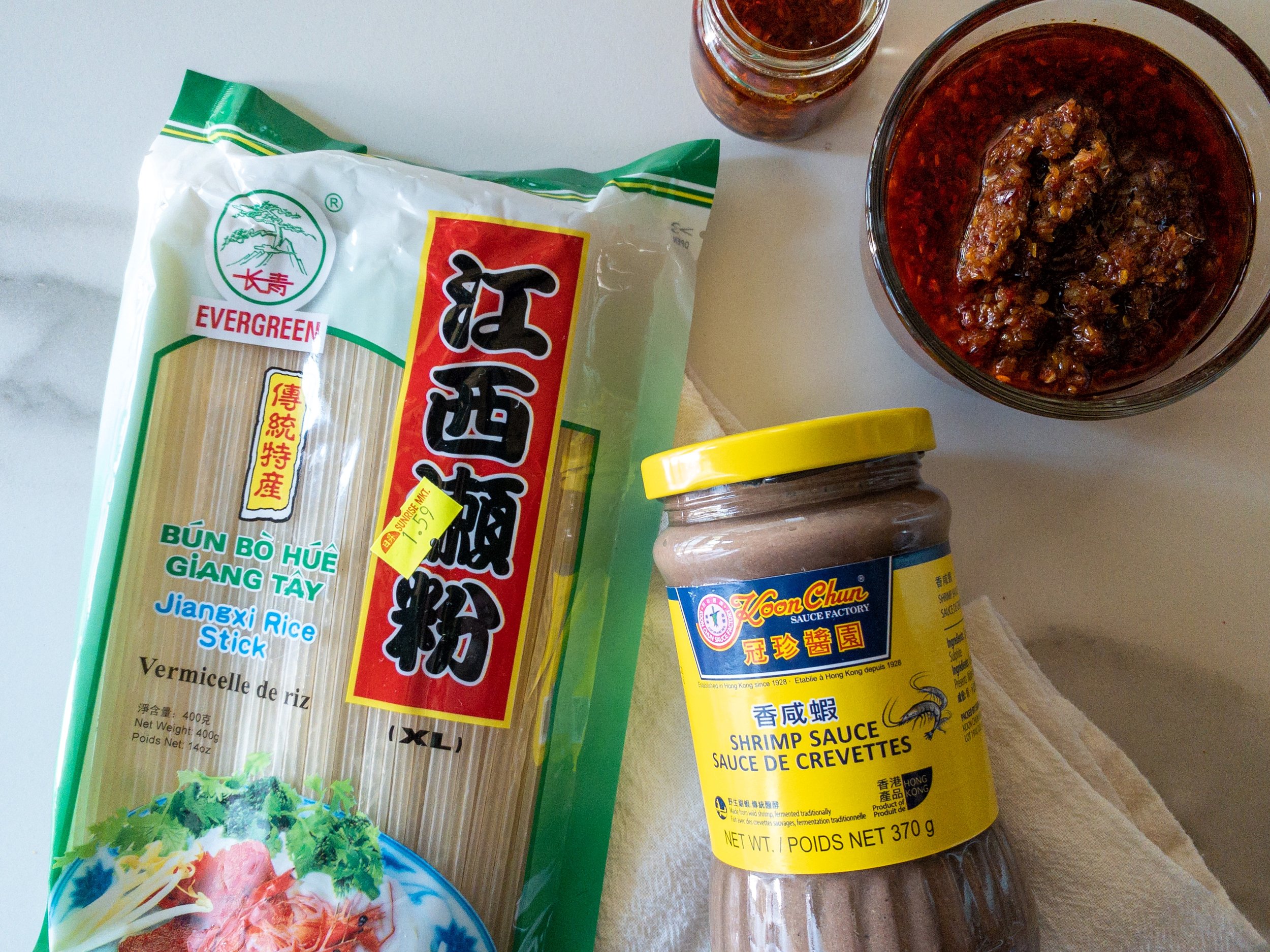Bún Huế, Central Vietnam Noodle Soup with Moose
A bag of moose bones and deboned shank meat boiled for hours with annatto seeds produced a deep broth for Bun Bo Hue. It's my father's favourite national dish from central Vietnam and translates to Hue Beef Noodles, but I'll refer to it as Bun Hue since there's no beef, only moose meat.
Real talk, it's a struggle for me to write recipes for Vietnamese Noodle Soups. The country is obsessed with clear broths, which are tricky to master. Because of so many variables, it's not easy for me to explain how to taste and adjust things in written text. From my experience, three people could follow the same recipe and end up with entirely different tasting soups. My goal in saying this is to encourage you to use this recipe as a guide and keep seasoning it to your liking.
Cooking Vietnamese noodle soups are a process of gathering ingredients, making the broth and prepping all the side and toppings to assemble the bowls. Preparing this dish is typically an all-day affair, and if you're like me and only have 1 hour a day to contribute to cooking, I highly recommend breaking this up into a three-day matter. It looks like this: day one grocery shop, day two make lemongrass chilli oil and broth, and day three prep toppings and assemble bowls to enjoy! Often this doesn't have in simultaneously and is a week-long venture.
I hope this suggestion makes cooking these bowls of comfort more enjoyable. The good news is that once done, you'll have a hot meal for a few days, or you can freeze the broth, slices of meat, and chilli oil for a rainy day.

Bun Hue, Central Vietnam Noodle Soup with Moose
Ingredients
Instructions
- I like to get the lemongrass chilli oil out of the way and let it age. It will taste better the longer it gets to marinade. The more efficient method is to make it while you wait for the stock to cook - I'll leave it up to you to decide what to do. It's crucial to mince and measure all oil ingredients before cooking because it moves and burns fast.
- For the Sa Tế add 2/3 cup of grape-seed oil and 2 tbsp annatto seeds in a small sauce pot. Gently heat on medium-low heat until the oil gets warm and turns a deep red colour. Keep watch because the seeds can quickly burn. Strain the seeds and add back the coloured oil to the pot. Add 6 minced garlic cloves to the pot and cook until the raw smell is gone about 2 minutes. Add 6 tbsp minced frozen lemongrass, and cook for about 3 minutes. Turn off the heat and add 3 tbsp chilli flakes, 2 tbsp Korean chilli powder, 2 tbsp sugar and 5 tbsp fish sauce.
- Start the broth by washing all the bones and shank the meat in cold water. Add them to a pot, add enough water to cover the bones, and bring to a boil for 5 minutes. Dump everything into a sink, clean the pot, and rinse the meat in cold water until all the brown bits are gone. Optional, tie the deboned shank like a roast. The rope will make it easier to slice thin after it's cooked.
- Add all the parboiled protein to the pot, cover with cold water, and sit on medium heat on the stove. In the same pot, add 1 yellow onion, 1 inch of peeled ginger, 1 can of pineapple, 2 tbsp rock sugar, 1 tbsp MSG (or Chicken stock powder or both), 1 tbsp salt and 4 tbsp fish sauce. Bring to a boil, and turn it down to a simmer for 3 to 4 hours. Occasionally, skimming the top of scum.
- The shank meat should be tender at the two-hour mark, but this is all about personal preference. Scoop it out and dunk it in ice-cold water to ensure it remains moist for at least 10 minutes. Store in an air-tight container in the fridge until it's cooled for easier slicing.
- At the three or four-hour mark, remove the onions, ginger, lemongrass, and pineapple from the stockpot. Season stock with additional chicken stock powder, fish sauce, salt, rock sugar, and fermented shrimp paste to your liking. For the fine shrimp paste, it's best to whisk it together with a bit of the hot stock water to prevent clumps, then pour it into the stockpot. Add about 1/3 of the lemongrass chilli oil. Add in puffy tofu at this point to cook in the broth.
- Start prepping the ingredients and slice the chilled shank meat for assembling the bowls. Soak noodles in warm water until soft, about 15 to 30 minutes. This extra step will help reduce the boiling time and produce a less mushy noodle. When ready to eat, add noodles into boiling water until soft. Once again, this depends on the brand and thickness of the noodles. Place a colander in the sink and drain noodles into the colander. Rinse with cold water to prevent sticking.
- To assemble the bowls, add a handful of noodles, sliced meat, red onion, cilantro, green onion, basil, and sliced Vietnamese ham. When everyone is ready to eat, ladle boiling broth into the bowls and 1-2 pieces of puffy tofu into the bowl.
- Everyone can squeeze in lime or scoop additional chilli oil. Enjoy right away!

